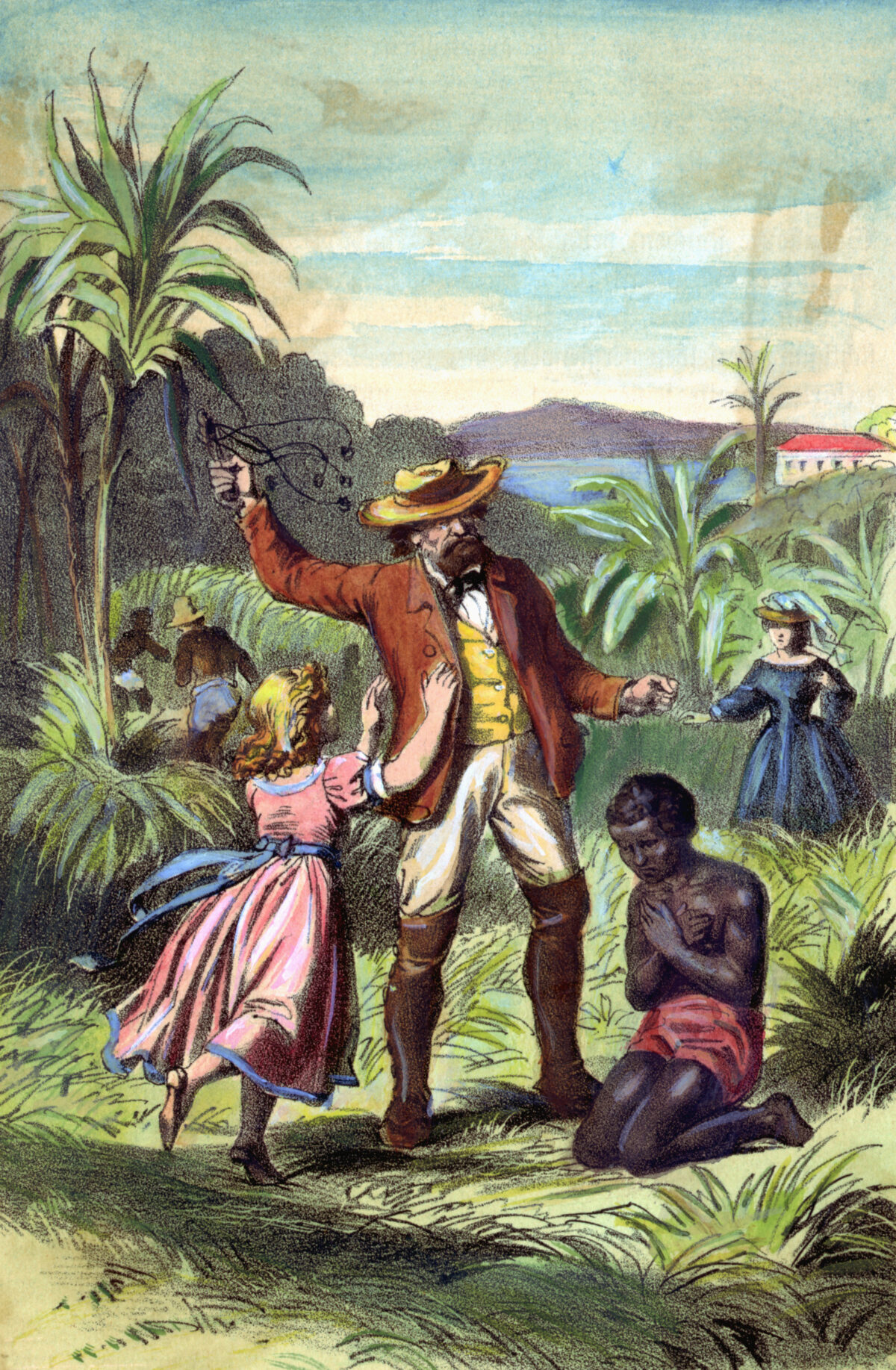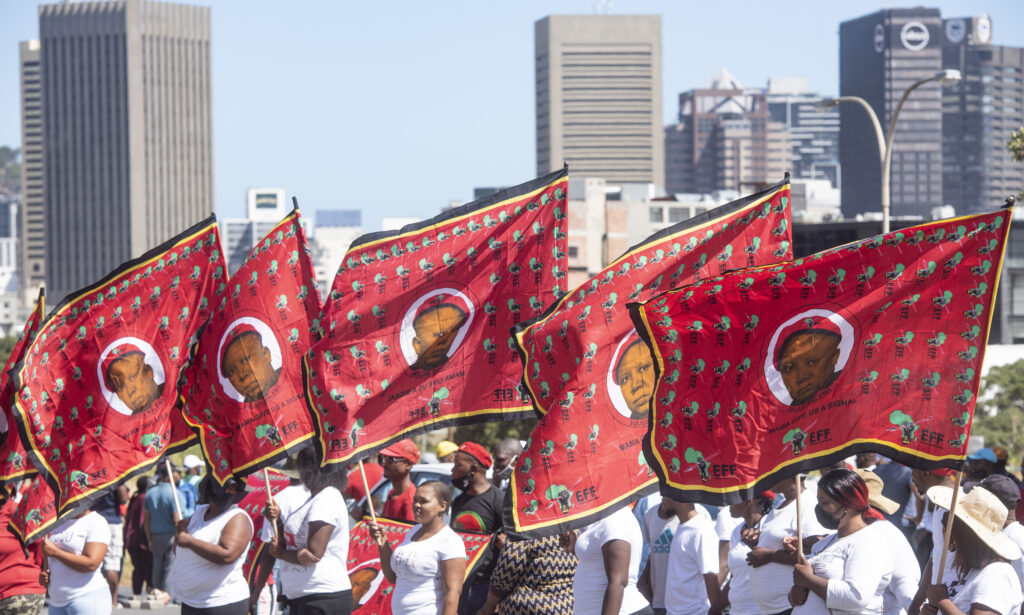The hand-coloured lithograph offers an unambiguous representation of violence. It depicts a white sugar estate slaveholder beating a black slave with a cat o’ nine tails. Essential for understanding the action here is, of course, the combination of slavery as an instrument of exploitation for capital gain and racism as a system of values based on the belief that whites are superior to blacks in all the relevant ways.
I suspect the author of the lithograph was acquainted with [Georg] Hegel’s dialectic of the lord and bondsman in the Phenomenology of Spirit. At any rate, they both betray an awareness that the social relation of master and slave mimics and replicates, in a different key, the Judeo-Christian relation of devotion and servitude between the finite creature and the infinite being. The slave is on his knees with eyes downcast. His arms are folded on his chest like a penitent and contrite sinner. His face speaks of resignation. It is no accident that the dialectic of the lord and bondsman in the Phenomenology of Spirit makes itself explicit in the form of experience Hegel calls “The Unhappy Consciousness” whose first form is the consciousness that the self, being finite, is nothing, and that the other, being infinite, is everything.
Let’s examine the details and composition of the lithograph more closely. The slaveholder’s right arm is raised. The cat o’ nine is swinging in the air. He’s about to beat his slave again. A young white girl intercedes. She’s rushing to the slaveholder, no doubt her father. Her arms are raised in a pleading gesture; it appears she’s importuning her father to put an end to the violence.
The white woman in a pretty blue dress with an umbrella in her hand in the background on the right behind the slave is no doubt the girl’s mother and the slaveholder’s wife. She looks apprehensive for her daughter: her right arm is poised in mid-air. Her demeanour conveys a feeling of hesitation. Should she rush to protect her child from her husband? He might hit her with the cat o’ nine by mistake. Or should she stay put and not interfere where her husband has absolute sway, with the management of the plantation and of the chattel that pertains to it? Behind the mother, in the distance on the right, one sees the family estate built by an estuary or river.
Note the symmetry of figures. There are three white and three black characters. The mother, father, and daughter are dressed in expensive clothing in the fashion of the mid to late 19th century. The daughter has shoes with heels and a pink dress with a blue ribbon tied round her waist. Her father is clad in boots, trousers, a shirt and bowtie, a vest, a coat and a sun hat. The African characters, all male, are scarcely clad: only one of them is wearing a sun hat and all three are wearing pants. They are bare-chested, bare-legged and their feet are unshod.
The author of the lithograph is unknown. It is dated by the Bettmann Archive to about 1870. Politically, it is anti-slavery and in defence of the Union. It is drawn in the background of the American Civil War (1861-1865), the ratification of the Thirteenth Amendment abolishing slavery in 1865, the ratification of the Fourteenth Amendment in 1868 that made African Americans US citizens, the ratification of the Fifteenth Amendment in 1870 granting African Americans the right to vote, and the backlash in some of the Southern States, with black massacres during the 1860s and 1870s. The Ku Klux Klan, for instance, was formed in 1865 in Pulaski, Tennessee.
No doubt the author means to insist on the dehumanisation of the slave and on the systematic violence to which he and she are subject on the plantation and in the home of the slaveholder. From a [Immanuel] Kantian and [Johann] Fichtean perspective, you dehumanise your neighbour when you treat her as a means and not as an end-in-itself, that is, as a thing and not as a person; and slavery, which involves the sale and purchase of human beings, consists of nothing else. In other words, I dehumanise my neighbour when I rob him of his autonomy, subject him to my will and treat him as a thing to be bought and sold on the market or as an instrument of capital accumulation. But there is more to it than that, and it is in view of this “more” that I have chosen to read this picture.
Its political significance is clear. The young white girl represents the normative standpoint every uncorrupted white person ought to take — uncorrupted by the institution of slavery and by the prejudices that underlie it. She is the image of what’s right and just, of the defence of liberty and equality and of the freedom from oppression. Her representational value suggests the author’s Rousseauism. He no doubt chose to draw a young innocent-looking girl to represent justice and rightness because he thinks that society corrupts and that it is those who are furthest from it or who are outside it — children, the poor, the “savage” — who are the least corrupted and who are able, as a result, to naturally express their innate sense of what’s right and just and good. (Let’s recall that society for [Jean-Jacques] Rousseau is the rich, the hypocrite, and the morally and politically bankrupt).
The girl is outraged by her father’s behaviour; and so the message conveyed is how every good white American ought to be about slavery and the authorities in the South that still lend it support. Unlike the mother in the background who is tainted by society and who thinks of herself and of her own family, the little girl fearlessly challenges the authority of her father without a thought for herself. She throws herself between her father and the slave willingly and without hesitation, knowing that she may come to harm: her father may beat her or the cat o’ nine may hit her by accident.
The slave is not dehumanised at the point where the cat o’ nine lacerates his skin. Laceration is not in itself dehumanising. Think of the self-lacerating Christian or, indeed, of the masochist who begs his dom to keep harrowing his flesh. No, what stands out in the lithograph is something else, and it is something else again than the contrast between the abject poverty of the slaves and the obscene wealth of the lord. It is the contrast between the way the girl responds to her father’s authority and the way the slave responds to the same, his master’s. She witnesses the injustice on the plantation and she responds to it recklessly, without forethought for herself, and violently, in defiance of her father’s authority.In contrast, the slave remains subservient to his master and looks contrite. His apparent resignation is as intolerable as the girl’s heroism, for her heroism masks the fact that he cannot respond with outrage and violence to the injustice he suffers as the “good white American” does or ought to. The “progressive” standpoint depicted in the lithograph obscures the fact that the slave is brought beyond the point where he can still answer to the master’s brutality. What testifies to his dehumanisation, in other words, is not simply his subjection to the master or the fact that he’s treated as a thing; it is the glaring absence of a violent response on his part.




